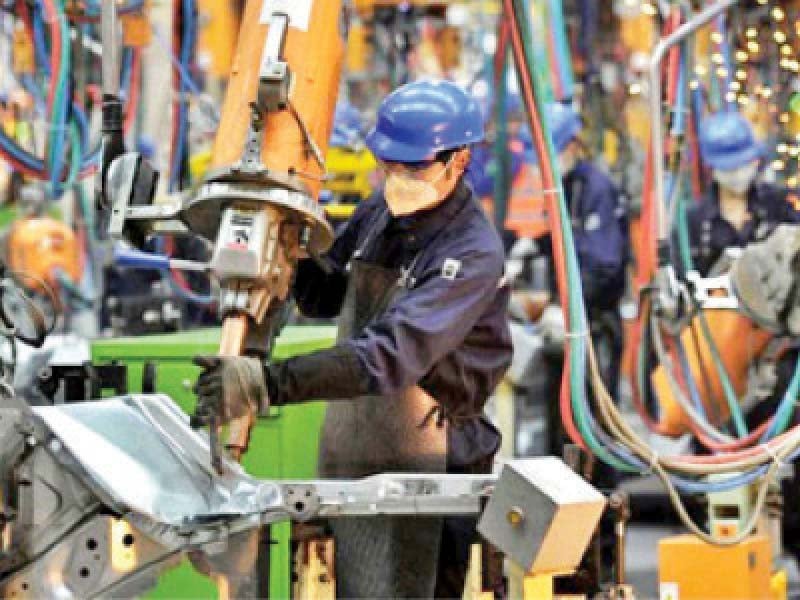
Big industries grew 10.4% during the first nine months of current fiscal year on the back of a low base effect and better output in sugar and apparel sectors, increasing prospects of achieving around 5% overall economic growth in this fiscal year.
Large-scale manufacturing (LSM) industries recorded 10.4% growth during July-March of the ongoing fiscal year over the same period a year ago, the Pakistan Bureau of Statistics (PBS) reported on Friday.
PBS data suggested that the increase largely came from the food sector, which has over one-tenth weight in the LSM index and apparel wear, which has 6.1% weight.
The other factor that contributed to the healthy momentum was the low base, as the index was at 126 in March last year, which jumped to nearly 154 this year.
The past year’s trend suggests that the LSM will post higher growth in April and May as well due to the low base effect.
The 10.4% growth during the first nine months of current fiscal year has strengthened the chances of achieving around 5% gross domestic product (GDP) growth in this fiscal year ending in June.
The increase in sugarcane and sugar production will offset the 1.5 million tons’ decline in wheat production.
The economic advisory wing of the finance ministry, which till March had been predicting around 5% overall growth rate, has suddenly cut the forecast to 4% in its latest publication.
Contrary to that, the Planning Commission expects the growth rate in the range of 5% to 5.4%, which will be higher than the last PTI government’s target for the current fiscal year.
The National Accounts Committee – the body that works out the growth estimates on the basis of input from the provincial and federal government departments – will meet by the mid of next week to approve the provisional growth rate for fiscal year 2021-22.
The new government has decided to revive the stalled International Monetary Fund (IMF) programme, which may also result in fiscal and monetary tightening to bring economic stability. This could hurt growth prospects for fiscal year 2022-23.
The previous government had targeted 4.8% economic growth for the current fiscal year. The IMF and other financial institutions have projected Pakistan’s economic growth in the range of 4% to 4.3%, which is a decent rate but nearly half of what is required to create jobs for all new entrants in the market.
The central bank has injected hundreds of billions of rupees into the economy, which provided a fresh impetus to the economic growth but fueled inflation in the country.
The LSM data is collected from three different sources. Data collected by the Oil Companies Advisory Council (OCAC) showed that the output of 36 items increased on an average by 2% in the first nine months of current fiscal year.
The Ministry of Industries, which monitors 11 products, reported a 10.3% increase in output during the July-March period. Provincial Bureaus of Statistics reported 12.1% growth in the output of 76 goods, stated the PBS.
On a yearly basis, the LSM sector showed 26.6% growth in March over the same month of last year. However, half of the increase in March output was because of increased production of sugar by the mills.
The industries that posted growth in the first nine months of current fiscal year included textile, which registered 3.2% growth.
The textile industry is the largest sector in the LSM index, having 18.2% weight. The production of apparel wear increased 34% during the first nine months of FY22.
The output of food industry increased 11.7% during the period under review. Beverages sector production marginally grew by less than 1%, which was slower than the previous reading.
Coke and petroleum products’ output showed only 2% growth while chemicals’ output rose 7.8%, according to the national data collecting agency.
The output of automobile sector increased by 54%. The iron and steel sector saw a growth of 16.5% while the manufacturing of leather products rose 1.5%.
The paper and board sector grew 8.5% and wood products’ output expanded 157% but their weight is very low in the overall index, having little impact on the growth rate.
Five sectors remained in the red during the July-March period. These included the pharmaceutical sector whose output decreased marginally while rubber products’ output decreased by 21%.
The fabricated metal, electric equipment and transport equipment output also shrank during the current fiscal year.
Published in The Express Tribune, May 14th, 2022.
Like Business on Facebook, follow @TribuneBiz on Twitter to stay informed and join in the conversation.

1729662874-0/One-Direction-(1)1729662874-0-405x300.webp)


1722421515-0/BeFunky-collage-(19)1722421515-0-165x106.webp)




1732084432-0/Untitled-design-(63)1732084432-0-270x192.webp)








COMMENTS
Comments are moderated and generally will be posted if they are on-topic and not abusive.
For more information, please see our Comments FAQ